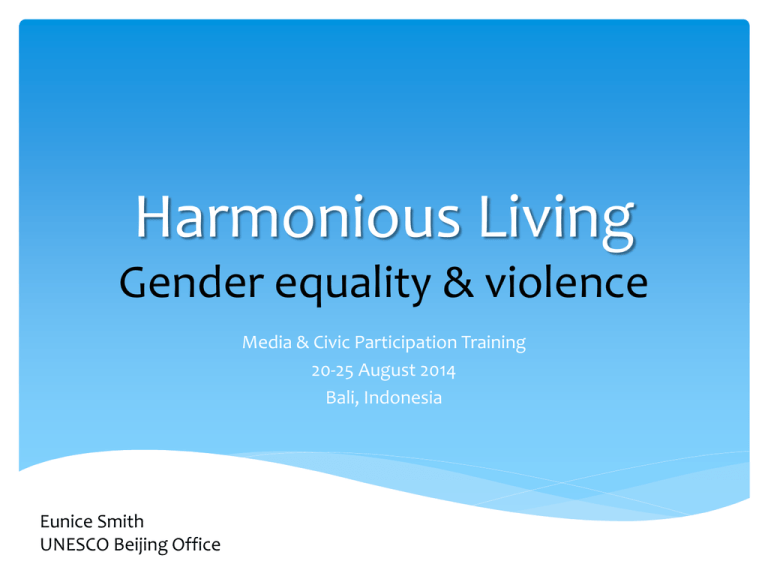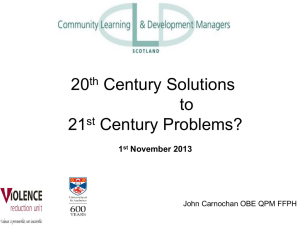
Harmonious Living
Gender equality & violence
Media & Civic Participation Training
20-25 August 2014
Bali, Indonesia
Eunice Smith
UNESCO Beijing Office
Harmonious Living
Gender equality & violence
A
G
E
N
D
A
Gender equality & gender roles
Two exercises
Key basic concepts
Focus on Gender-based violence
Public or private matter
Closing reminders
Ice breaker exercise
Man or Woman: Who invented…?
Instructions
- Identify whether it was a woman or a man who invented the
pictured object.
- Explain the reason(s) for your response.
Objective of the game
- To begin questioning perceptions of roles played by women and men
in society.
Ice breaker Game
Man or Woman: Who invented?
The Vacuum
cleaner
1/10
1
James Spangler - 1907
What sparked the invention?
• The carpet sweeper he was
using, as a janitor, was
making his asthma worse
Ice breaker Game
Man or Woman: Who invented?
The windshield
wiper
3/10
2
Mary Anderson - 1903
What sparked the invention?
• Anderson's invention came about
during a trip to New York City when
she noticed that streetcar drivers had
to open the windows of their cars
when it rained in order to see
• People thought windshield wipers
would be too distracting to use until
1916 when it became standardized for
every vehicle
Ice breaker Game
Man or Woman: Who invented?
The dishwasher
5/10
Inventors – both male and female
Joel Houghton - 1850
• First Inventor of the machine
• Not very practical - The machine
only splashed water on the
dishes
Inventors – both male and female
Josephine Cochran- 1886
• Invented the first practical dishwasher
What sparked the invention?
• Invented the machine to protect her
china that her servants were chipping
while washing and cleaning them.
Ice breaker Game
Man or Woman: Who invented?
Kevlar
( Main ingredient for bullet
proof vests)
7/10
4
Stephanie Kwolek - 1966
• Kevlar – 5 times stronger than
steel and resistant to flames
•
Kevlar is also used in dozens
of other products, including
skis, safety helmets, hiking,
camping gear, and suspension
bridge cables.
Ice breaker Game
Man or Woman: Who invented?
The Microwave oven
9/10
5
Percy Spencer - 1945
What sparked the invention?
• While he was researching radar
at the Raytheon company. He
felt the chocolate bar in his
pocket melt when he stood close
to a high frequency radio waves
machine called a magnetron
10/10
Survey Exercise
Who in your family is responsible for?
Instructions
- Indicate by a show of hands who is responsible for the following roles in
your family.
Objective of the game
- To begin questioning perceptions/roles played by women and men in the
family.
1/4
Survey Exercise
Who in your family is responsible for?
Role
Pays the rent?
Decides that a sick
family member
should see a doctor?
2/4
Mother Father
Other
Survey Exercise
Who in your family is responsible for?
Role
3/4
Decides on the
purchase of a new
car?
Decides to invest in
the stock market &
which stocks to buy?
Mother Father
Other
Survey Exercise
Who in your family is responsible for?
Role
Decides if the family
should take a
vacation?
Decides where to go
for that vacation?
4/4
Mother Father
Other
Lessons learned
Gender roles – discussion
1. What were your impressions of the reasons
given for identifying a woman or a man as the
inventor of an object in the first exercise?
2. What patterns, if any, did you identify in the roles
played by women and men in households?
3. Are these assigned roles the same across ethnic
groups, countries, cultures?
1/2
Lessons learned
Gender roles – discussion
4. How are roles assigned to women and
men?
5. Can roles change over time? Do you
have examples?
6. What are some of the factors that
influence how roles change?
2/2
Key basic concepts
Gender: Refers to the economic, social, political and cultural
attributes and opportunities associated with being male and
female.
Sex: Refers to the biological differences between women and
men.
Gender equality: Refers to women and men having equal
opportunity, without distinction, to participate fully and
achieve self fulfillment. It does not imply that women and men
are the same, but that they have equal value and should be
given equal treatment.
1/3
Key basic concepts
Gender roles: Social roles that women and men play in society.
Gender sensitive: Acknowledging differences and inequalities
between women and men as requiring attention
Gender equity: Targeted measures that are often needed to
compensate for historical and social disadvantages that
prevent women and men from otherwise being equals.
Empowerment: Collective and individual process of women and
men having control over their lives, setting their own agendas,
gaining skills, building self-confidence, solving problems and
developing self-reliance.
2/3
Key basic concepts
Gender-based violence: Violence – physical, including sexual,
mental, or psychological - targeted against individuals or
groups of individuals on the basis of their gender, gender roles
and expectations of a society or culture.
Interpersonal violence: Includes violence between family
members and intimate partners and violence between
acquaintances and strangers that is not intended to further the
aims of any formally defined group or cause.
(See p11 of Workbook for more basic concepts)
3/3
Reflection questions
How are you contributing to or breaking
gender stereotypes?
How are you contributing to equality
between men and women?
Gender-based violence
Instructions
- View the short movie produced by the Mankind Initiative.
- Form groups of all women, all men, and a mixed sex group, and
nominate a rapporteur and presenter who would report back to plenary
on group answers to questions below.
- In your group, discuss the questions below.
Objective of the exercise
- To begin questioning attitudes, behavior and practices with respect to
gender-based violence
Applied Learning
Group work
What were the reactions of bystanders?
Why do you think the reactions were
different with the woman and then the man?
Would you intervene if a man or a woman
was being assaulted?
Are there factors that would prevent you
from intervening?
Source of the video
• The ManKind Initiative is a
domestic violence charity based
in the United Kingdom
• Since becoming a charity in 2001,
it has provided training and
support for the local authorities
and campaigns to ensure that
equal recognition is given to
male victims in the same way
that recognition is given to
female victims of domestic
abuse.
Applied Learning
Group work
What were the reactions of bystanders?
Why do you think the reactions were
different with the woman and then the man?
Would you intervene if a man or a woman
was being assaulted?
Are there factors that would prevent you
from intervening?
Applied Learning
Discussion
Group Answers
Violence – Public or Private matter?
Discussion
Objective of
the exercise:
- To
consider the
implications
and costs of
violence
Consider and develop the following scenario:
A couple has a disagreement in their home and then
begin to physically assault each other. Furniture gets
thrown around and things get broken. The children
in the home get scared and begin to cry. There is a
lot of noise and disturbance.
seriously hurt.
One person gets
Someone calls the emergency
hotline… What happens next?
Violence – Public or Private matter?
Discussion
1. Is a fight between the two persons a public or
private matter? Why?
2. What are some of the implications for and costs
to the different actors in the scenario of
violence that you have developed?
3. Given your answer to the question above, do
you consider violence to be a public matter?
Closing reminders
Gender-based Violence – Violence can affect everyone. It is
destructive and costly to the individuals concerned and the
society where it takes place. Each individual has to make an
effort to stop gender-based violence.
Gender Roles – Gender roles have changed over the years
and will keep on changing. How they change….depends on
you.
Gender Equality - Inequality increases the likeability of
violence. We need to pay attention towards our language
and assumptions we make, as they will impact our actions.
The End!
Thank you for your
participation!










